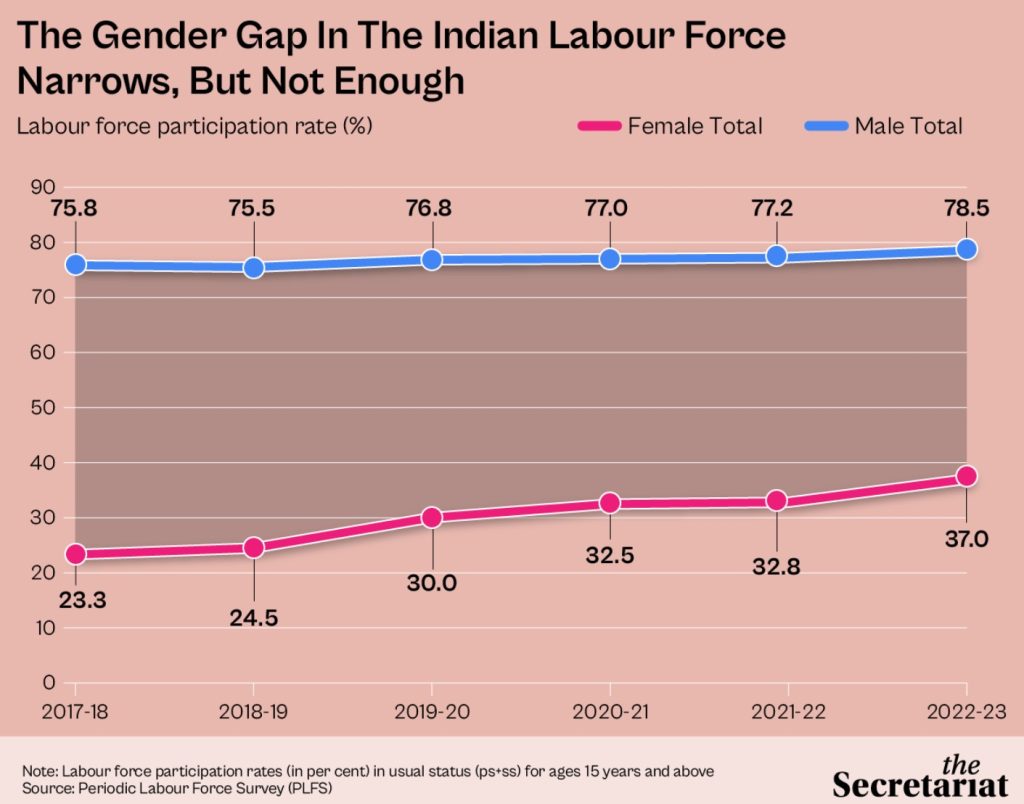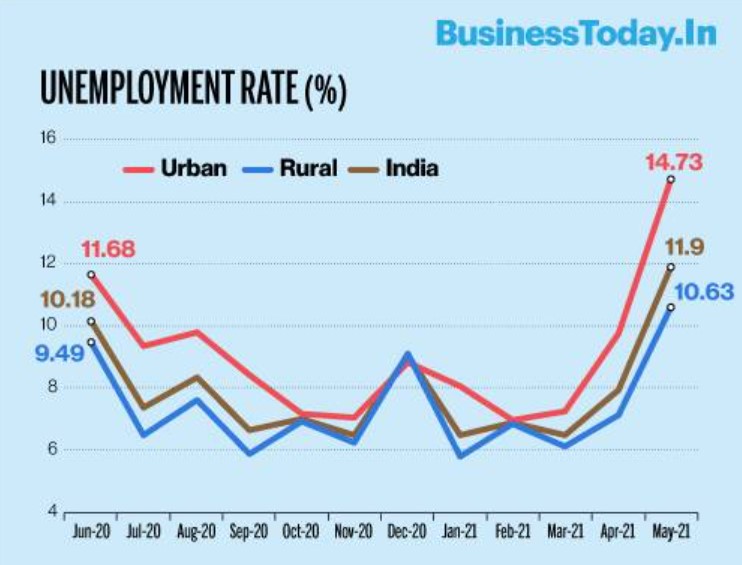CONTENTS
- Reducing Work Hours of Women
- Creating Employment in the Long Run
Reducing Work Hours of Women
Context:
The last thing a rape and murder require are empty words, yet a tired and predictable response is being offered after the brutal killing of a female doctor on duty at Kolkata’s R.G. Kar Hospital on August 9. The West Bengal government has issued guidelines, including one that suggests minimizing night shifts for women.
Relevance:
GS2-
- Welfare Schemes for Vulnerable Sections of the population by the Centre and States and the Performance of these Schemes
- Issues Relating to Development and Management of Social Sector/Services relating to Human Resources
GS3- Growth, Development and Employment
Mains Question:
In light of the recent violence against women in their workplaces, reducing work hours of women and minimizing night shifts for them presents a way to ensure their safety. Comment critically. (15 Marks, 250 Words).
Women in Workforce:

- According to the Periodic Labour Force Survey (PLFS) conducted by the National Statistical Office (NSO), the Worker Population Ratio (WPR) for women aged 15 years and above was estimated at 28.7% in 2019-20.
- However, the most recent PLFS report indicates a rising trend in the Labour Force Participation Rate (LFPR) for women, which reached 32.8% in 2021-22.
- Despite this increase, the rate remains below the global average of 47% and is significantly lower than that of countries like China, where the female LFPR stands at 60%.
- It is also lower than that of some neighboring South Asian countries, such as Sri Lanka and Bangladesh.
Avoiding Night Duty- A Regressive Approach:
- How does this directive—“wherever possible, night duty may be avoided for women to the extent possible”—enhance workplace safety?
- This regressive approach will only push women out of the workforce rather than addressing the root cause of violence.
- With the labor force participation rate for urban women in India, aged 15 and above, at a dismal 25.2% in April-June 2024, according to the Periodic Labour Force Survey’s quarterly bulletin, both the central and state governments must ensure that women—whether they are healthcare professionals, gig workers, factory employees, call center staff, auto drivers, hotel workers, or journalists—can work safely, anywhere, at any time.
- Reducing their working hours will only result in women losing jobs and financial independence.
- The other guidelines, part of the ‘Rattirer Shaathi (Helpers of the Night)’ program, include separate restrooms and toilets for women, the creation of safe zones with CCTVs, and a special mobile phone app—measures that should have already been implemented.
Existing Notifications on the Issue:
- Several states, including Telangana, Madhya Pradesh, and Tamil Nadu, have issued allowing commercial establishments to employ female workers during the night shift.
- Haryana has updated the conditions that commercial establishments must meet in order to require female employees to work at night.
- Similarly, Himachal Pradesh, Odisha, Andhra Pradesh, and Uttar Pradesh have recently outlined conditions for granting exemptions to factories from the application of Section 66(1)(b) of the Factories Act, 1948.
- Ensuring workplace diversity cannot be achieved without providing equal opportunities to all individuals.
- Legal provisions that prohibit female employees from working night shifts have been criticized for denying women the same opportunities as their male counterparts.
- According to case law, employers cannot refuse jobs to female workers based on the requirement of night work.
- This aligns with the Madras High Court’s 1999 judgment, which declared Section 66(1)(b) of the Factories Act, 1948, unconstitutional.
- To promote inclusive workplaces, several states continue to issue notifications that permit employers to engage female employees in night shifts.
- These notifications also include various safety and security measures that employers must implement to benefit from the exemption.
Way Forward:
- The Supreme Court, taking suo motu cognizance of the Kolkata case, announced the formation of a national task force on Tuesday to address the safety of doctors and medical professionals.
- Gender violence is a critical issue that demands serious attention in all areas, particularly in the informal sector where large numbers of women are employed.
- The extensive reforms implemented after the 2012 Delhi rape case, including stricter laws and harsher punishments, have proven insufficient.
- According to the National Crime Records Bureau’s (NCRB) 2022 report, the most recent available, 4.45 lakh cases of crimes against women were registered, which equates to nearly 51 FIRs every hour.
- Protocols must be more than just words on paper, as emphasized by Chief Justice of India D.Y. Chandrachud.
- In 2017, while upholding the death penalty for four men convicted in the 2012 Delhi rape case, Justice R. Banumathi highlighted that beyond effective law enforcement, a societal mindset shift and public awareness on gender justice are essential to combating violence against women.
Conclusion:
The “reclaim the night” campaigns led by women after the R.G. Kar Hospital rape in Kolkata and other parts of the country should be seen as wake-up calls for both governments and society to take meaningful action for women’s rights.
Creating Employment in the Long Run
Context:
One significant flaw in the annual Budget process is that it provides the Finance Minister with a platform to make grand announcements that generate headline news. The following year, more announcements are made, leading to new headlines, but no one checks whether the previous year’s high-profile schemes were actually implemented successfully.
Relevance:
GS3-
- Indian Economy and issues relating to Planning, Mobilization of Resources, Growth, Development and Employment.
- Inclusive Growth and issues arising from it.
Mains Question:
What are the low- hanging fruits in India for generation of more employment opportunities? Have the government’s recent initiatives tried towards their efficient utilisation? Analyse. (15 Marks, 250 Words).
From Disinvestment to Employment:
- For several years, the current Finance Minister used to set ambitious disinvestment targets, with the proceeds expected to significantly reduce the fiscal deficit.
- However, these efforts largely failed to materialize (except in cases where one government entity purchased a stake in another).
- This year, the focus shifted from disinvestment to employment announcements.
- While it is good that the jobs crisis is finally being acknowledged, these plans also seem unlikely to be fulfilled.
- A month after the announcements, there has been little substantial progress.
The Five-Scheme Package:
- The Finance Minister introduced a five-scheme package aimed at addressing unemployment. Borrowing ideas from the Congress party’s manifestos, the government proposed incentivizing corporations to take on 1 crore interns over the next five years. However, the design of this scheme makes it unlikely to succeed.
- The internship program is limited to the top 500 companies, excluding micro, small, and medium enterprises, which could benefit from lower-cost interns. This exclusion makes little sense.
- The scale of the program means that each company would need to take on an average of 4,000 interns every year. Yet, most companies don’t even have 4,000 permanent employees.
- With Artificial Intelligence making more jobs redundant, why would companies suddenly double or triple their workforce?
- The day after the announcement, the Finance Minister clarified that the scheme was not mandatory, just a suggestion.
- The opposition’s Right to Apprenticeship proposal was designed to be open to all companies and was based on implementing an Apprenticeship Act that meets the needs of both job seekers and employers.
- It recognized that giving young people the chance to learn and train on the job in a supportive environment could greatly improve their skills, helping them overcome gaps in their education and training. However, these nuances are completely overlooked by the government.
- While employment-linked incentives are a good idea in principle, the government made a mistake by choosing measures that are destined to fail.
- Similar to the Atmanirbhar Bharat package, the government is primarily relying on supply-side solutions to address problems that are mainly driven by a lack of demand.
- The government is offering to finance a portion of the recruitment costs, but if demand doesn’t increase and production capacity remains unchanged, which company would risk reducing its profit margins by hiring more workers?
The Job Crisis:

- Just before the Budget, a report by Citigroup Inc. highlighted the ongoing job crisis, causing concern within the government.
- In response, the Reserve Bank of India (RBI) quickly released data claiming that about 109 million jobs were created between 2019-20 and 2023-24.
- However, experts have questioned the reliability of this data due to its methodological limitations, as it relies on extrapolated population data and various employment surveys.
- Moreover, the claim doesn’t hold up under scrutiny. If 109 million new jobs had been created, the labor force participation rate should have seen a significant increase, but the latest Periodic Labour Force Survey (PLFS) shows only a 4% point rise since 2019-20.
- Most of the reported job creation comes from people moving into agriculture and self-employment. Nearly 46% of the workforce is now ’employed’ in agriculture.
- Given that agricultural income hasn’t seen a significant rise, it suggests that people are turning to farming because there are no better job opportunities elsewhere.
- Additionally, MGNREGA data indicates that in 2024-25, 24.8 lakh new individuals were added to the job cards, and a total of 5.8 crore people have already sought work, pointing to growing rural distress.
- During the decade of ‘Make in India,’ the share of manufacturing in the workforce actually declined from 12.6% in 2011-12 to 11.4% in 2022-23.
- Job-creating sectors like textiles, electronics, leather, and paper products have experienced negative industrial growth.
- The recent tragedy in Delhi, where three students preparing for government exams drowned, highlights the desperate conditions students endure to pass competitive exams.
- Millions of people endure these challenges because they view government jobs as the only path to upward social mobility.
- According to a Lok Sabha reply, the Ministry of Personnel reported that in the first eight years of the BJP government, 22 crore applications were received for government jobs, but only 7.2 lakh were hired.
- Currently, there are nearly 30 lakh vacancies in sanctioned posts at various levels in the Central government.
- The government could make a significant impact by ensuring timely recruitment and addressing issues like paper leaks.
Conclusion:
Instead of offering mere nudges, the government should focus on an economic package that supports long-term investment in essential public services. Emphasizing green jobs could have multiple benefits. Improving service delivery would greatly enhance the quality of life, help create a productive workforce, and generate more jobs.




